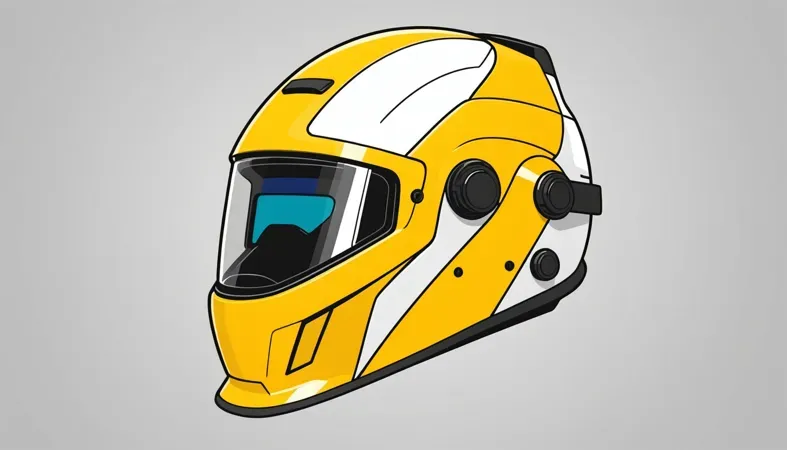What is X Mode on Miller Welding Helmet? Learn Function, Usage, & Benefits
Published on: April 20, 2025 | Last modified: March 4, 2025
By: Mark Carter
X-Mode is a feature on some welding helmets that helps detect your welding arc. It reduces interference from bright light, making it easier for the helmet to switch from light to dark.
I regularly get inquiries regarding what is x mode on miller welding helmet. This feature really matters because it enhances your visibility and control while welding. From my experience, using X-Mode can significantly improve your comfort level when working outdoors or in fluctuating light.
In this article, we’ll cover X-Mode, how it works, different types of X-Mode on Miller Welding helmets, steps to use X-Mode, and factors that influence its performance. You’ll also find helpful tips on how to use an auto darkening welding helmet effectively.
Contents
- What’s X-mode on a Miller Welding Helmet?
- How Does X-mode on Miller Welding Helmets Work?
- Types Of X Mode on Miller Welding Helmet
- Comparing Miller X-Mode with Other Brands
- Factors Influencing X Mode on Miller Welding Helmet
- Steps to Use X-mode on Miller Welding Helmet
- Frequently Asked Questions (FAQs)
- Conclusion
- Additional Reading
What’s X-mode on a Miller Welding Helmet?
X-Mode is a feature that enhances visibility by reducing interference from sunlight and reflective light. This helps you see your work clearly in bright conditions. It’s perfect for outdoor welding, where bright light can be an issue. To understand the numerical codes associated with welding rods, you can learn about welding rod numbers.
How Does X-mode on Miller Welding Helmets Work?
X-Mode is an advanced feature on Miller welding helmets. It uses unique sensor technology that reacts to bright lights, like sunlight or arc flashes, to darken the lens automatically. This prevents false darkening and ensures clear visibility when you need it most. With a switching speed of just 1/25,000 of a second, your eyes are protected without missing details.
This mode is ideal for outdoor work or jobs with changing lighting. X-Mode operates effectively even in challenging conditions, maximizing your ability to see and work with precision.
To use X-Mode effectively, start by adjusting the sensitivity settings on the helmet for your environment. Remember, X-Mode can be combined with auto-darkening features for optimal safety. When adjusting your auto-darkening welding helmet, make sure X-Mode is activated to enjoy full benefits.
Types Of X Mode on Miller Welding Helmet
What are the types of X Mode available on Miller welding helmets?
-
Auto-darkening Mode
This mode automatically adjusts the tint when you start welding. In X Mode, it reacts quickly to bright lights, protecting your eyes. To use, ensure the helmet is in X Mode, adjust the sensitivity for various conditions, and you’re set for welding!
-
Grind Mode
Grind Mode lets you work without auto-darkening, keeping the helmet clear. When activated in X Mode, it prevents accidental darkening while grinding metal. To engage this mode, switch your helmet to Grind Mode before starting your prep work.
-
Cut Mode
Cut Mode is designed for cutting applications, providing a suitable shade for oxy-fuel and plasma cutting. In X Mode, it ensures clear visibility. To use Cut Mode, select it on your helmet and match the settings to your cutting requirements.
-
Solar Powered Mode
Solar Powered Mode uses sunlight to recharge your helmet. In X Mode, this feature extends the lifespan, as it eliminates the need for batteries. To activate, expose your helmet to sunlight before starting work for uninterrupted power.
-
Low-light Mode
This mode enhances visibility in low-light conditions, allowing you to see clearly while working. In X Mode, it effectively adjusts sensitivity to dark environments. To enable Low-Light Mode, press the designated button on your helmet when in dim areas.
We’ve wrapped up the various Types of X Mode on Miller Welding Helmet here. Next up, we’ll look at Comparing Miller X-Mode with Other Brands.
Comparing Miller X-Mode with Other Brands
Here’s a breakdown of how Miller’s X-Mode stacks up against similar features from other popular welding helmet brands.
| Feature | Miller X-Mode | Lincoln Electric | ESAB |
|---|---|---|---|
| Sensor Sensitivity | Highly adjustable sensitivity settings ranging from low to high. | Good sensitivity, but less configurable. | Moderate sensitivity; fewer adjustments available. |
| Speed of Darkening | 1/25,000 seconds: quick responsiveness. | 1/20,000 seconds: slightly slower. | 1/30,000 seconds: the slowest among the three. |
| Light Interference Adaptability | Effectively filters bright light and reflects glare. | Moderate; can struggle with glare in strong sunlight. | Better in controlled environments but less effective outdoors. |
| Battery Type | Solar and rechargeable batteries. | Rechargeable only. | Battery-powered; no solar option. |
| Additional Modes | Grind, Cut, and Low-light options available. | Grind and Cut modes but no low-light. | Basic modes only, lacks specialized options. |
That covers the comparison of Miller X-Mode with other brands. Let’s now take a look at factors influencing X Mode on Miller welding helmets.

Factors Influencing X Mode on Miller Welding Helmet
What factors impact X-Mode on your Miller welding helmet?
-
Welding Environment Conditions
Environmental factors like wind and temperature can alter how X-Mode responds during welding. For example, a cooler environment may require a quicker reaction time to sudden brightness.
-
Types Of Welding Performed
The type of welding—TIG or MIG—matters too. Each process has different light intensities that can trigger X-Mode, so adjusting settings based on your technique is essential.
-
Intensity Of Light Exposure
X-Mode adapts to bright light from arcs and background glare. Use your helmet’s sensitivity settings to match the brightness for optimal performance. Excessive light can confuse the sensor, affecting its reaction time.
-
Helmet Sensitivity Settings
Adjusting sensitivity settings helps control the helmet’s response. Higher settings activate X-Mode faster, which is ideal for sudden brightness in various welding situations.
-
Type Of Power Source Used
The power source, whether AC (Alternating Current) or DC (Direct Current), influences X-Mode function. Different power types emit varying light intensities, impacting how quickly your helmet transitions from light to dark.
That covers the elements affecting X Mode on the Miller Welding Helmet. Let’s now take a look at the steps to use X Mode.

Steps to Use X-mode on Miller Welding Helmet
Here’s how to use X-Mode on your Miller welding helmet to maximize its functionality.
-
Activate X-mode
Turn on the helmet by pressing the power button. It should light up, showing the current mode. You’ll typically see the normal welding mode first.
Next, locate the X-Mode setting—usually a dedicated button or toggle. When activated, the helmet enters X-Mode, which reduces interference from bright light sources. This feature works best in outdoor settings or bright workshops.
-
Adjust Sensitivity Settings
While in X-Mode, adjust the sensitivity. Look for a knob or press a button until you see sensitivity options on the display. Higher sensitivity lets the helmet react to low-light conditions. I’ve found that setting it above the midpoint is effective when using lower amperage.
Always test it before welding. The goal is to find a setting that activates quickly without delay. If it doesn’t react fast enough, you’ll be straining your eyes, and that isn’t fun!
-
Customize Delay Settings
Customize the delay settings, which control how long your lens stays dark after you stop welding. Adjust it to your preference; I prefer shorter delays around 0.1 seconds to keep my vision clear for the next movement. Properly operating a welding machine involves understanding various settings and techniques that ensure safety and precision. For those looking to enhance their skills, mastering the operation of welding machines can be highly beneficial.
.
Experiment during practice sessions to find what works best for you. A delay that’s too long can cause eye strain, so pay attention to how you feel. It makes a big difference!
-
Test in Different Conditions
After setting everything, test your helmet in various lighting conditions. Go outside or into a brighter workspace and observe the helmet’s performance. X-Mode is designed to minimize the effects of ambient light without compromising your view.
After using it in multiple setups, I can attest to its efficiency in both bright sunlight and dim conditions. Keep adjusting until you find the sweet spot for your environment. A little time spent now saves you from headaches later!
We have now covered how to use X-mode on the Miller welding helmet. Next, we will examine frequently asked questions.
Frequently Asked Questions (FAQs)
Now let us look at some common questions I typically get asked about welding helmets.
How to Use an Auto Darkening Welding Helmet?
Using an auto darkening welding helmet is straightforward. First, adjust the sensitivity settings based on your environment, usually between 1 and 5. Then put the helmet on and start welding; the lens auto-tints within milliseconds after sensing the arc. Proper control of the welding arc can significantly impact the quality of a weld, and understanding the nuances can be crucial for achieving optimal results. More information about arc control on a MIG welder can enhance your welding skills.
How to Test an Auto Darkening Welding Helmet?
To test an auto darkening welding helmet, cover the sensors and trigger a light. The lens should darken quickly, confirming the helmet’s functionality. Remember, a functional helmet enhances eye safety during welding by blocking harmful rays.
What is Grind Mode on a Welding Helmet?
Grind mode on a welding helmet makes the lens clear. This setting lets you see clearly while grinding, ensuring your work area is safe. It’s essential for maintaining visibility without constantly raising the helmet.
How to Turn Off Auto Darkening Welding Helmet?
To turn off an auto darkening welding helmet, locate the switch, usually found on the side, and turn it to the ‘off’ position. This helps conserve battery life, as most helmets last around 2,000 hours of use on a single battery.
What Setting Should My Welding Helmet Be on?
The correct setting for your welding helmet depends on the process and materials used. For MIG or TIG, the shade should be set between 9 and 13 based on amperage. This ensures optimal visibility while protecting your eyes from intense light. When it comes to working on vehicle structures you might wonder if you can legally weld a car frame. For more information, check the regulations surrounding car frame welding.
Conclusion
Phew, we covered a lot about the X-Mode on Miller welding helmets. We looked at what X-Mode is, how it works, the various types available, steps to use it, and factors that impact its performance. Plus, we answered a few frequently asked questions to clarify any doubts you might have had.
So, what is X-Mode on a Miller welding helmet? Simply put, it’s a feature that enhances sensitivity to the arc in tricky conditions. This means it can help when welding outdoors or in bright surroundings, improving your overall welding experience. Happy welding!
If you’re keen to delve deeper into the world of welding, check out What is Welding to expand your knowledge.
Additional Reading
- American Welding Society. (2015). AWS D1.1/D1.1M: Structural Welding Code – Steel. Miami, FL: AWS.
- Smith, D. L. (2010). Welding: A Journey to Explore Its History. Dubuque, IA: Kendall Hunt Publishing Company.
- Little, R. L. (1999). Welding and Welding Technology. New York, NY: McGraw-Hill Education.
Mark is a skilled welding engineer specializing in advanced metal joining technologies and process design. With a formal education in welding engineering and a background rooted in practical experience, Mark bridges the gap between theory and application. He is passionate about making technical concepts accessible, empowering welders to embrace innovation while mastering essential skills. Mark combines his scientific expertise with a commitment to supporting the welding community alongside his uncle, Joe.
American Welding Society, Arc Control, Auto-darkening, Miller Welding, Regulations, Welding, Welding Features, Welding Helmets, Welding Skills, Welding Technology, X-Mode







